by scott.gillum | Jun 10, 2014 | 2014, Marketing
Tell me if you have heard this before; “we need more, and/or better leads.” The chances are, if you’re in hi-tech marketing you may hear it on daily, weekly and monthly basis. Why? According to Forrester consultant Tom Grant, it’s because of the need to feed the funnel.
In his report Tech Marketers Pursue Antiquated Marketing Strategies Grant compared hi-tech firms to other industries “B2B technology companies treat marketing as an opportunity to sell new products and services to new customers.” As he stated “the product is the axis around which marketing efforts turn,” and as a result, the primary objective of marketing is to produce leads.
Similarly, marketers have long held the belief that because of sales short-term focus on making quarterly objectives, it either lacks the appreciation of, and/or the sophistication to understand anything other than lead gen, for example longer-term brand building and awareness activities.
But what if both of these viewpoints were actually wrong. What would happen if you asked sales what they valued, rather than assumed you knew the answer? How might it change how marketing thinks about its impact on the organization?
For one B2B Tech Company, feedback from the sales force is helping them refine their value to the organization. “When it comes to enabling the sales force, we’ve previously relied on what I call “measurement-by-anecdote.” Our goal with this study was to quantify what sales values from marketing so we can focus on the things that make a difference.” said Rick Dodd, SVP Marketing of Ciena, a $2 billion global optical and packet networking company.
To gain that insight the company surveyed its global sales force, including five types of sales reps covering five different account types. Over 400 sales reps provided feedback on their priorities for marketing and marketing’s performance.
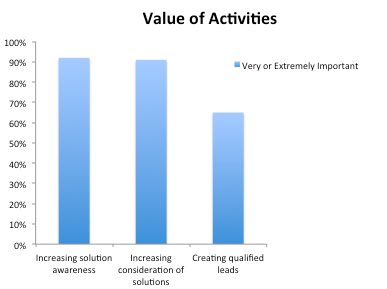
According to sales, the highest ranked marketing activities were at the top of the funnel, 92% of sales said that increasing the awareness of solutions was very or extremely important, increasing consideration was close behind at 91%, only 65% mentioned lead generation.
“Our sales force is very experienced; they understand that technology and industries change quickly. We’ve obviously been successful positioning ourselves for today’s market, and now we want to take best advantage of the big shifts in our landscape. The survey showed us that for sales to be successful, marketing has to be able to change customers and prospect perceptions,” according to Dodd.
Perhaps the most interesting insight to come out of the research, is how Ciena is now thinking about measuring and reporting marketing’s impact on the organization. “Measuring pipeline value is a struggle in our business”, said Bill Rozier, VP of Marketing. “We have long, complex sales cycles that make it difficult to isolate marketing’s impact.”And they are not alone it in that challenge. The Aberdeen Group’s recent Demand Generation study found that 77% of respondents rated visibility into lead performance across stages as very valuable, but only 43% indicated they can do thi effectively.
Instead of spending a lot of time and energy in trying to perfect an imperfect process, thecompany is focusing efforts on measuring marketing performance at the macro level. “At the end of the day, our performance is ultimately measured in sales success, so that’s what we are focusing on measuring”, said Rozier.
To do that, the company has created a quarterly dashboard from the survey. Two regional sales organizations each quarter will be asked to evaluate marketing’s performance in three areas: 1) Marketing’s contribution to sales success; 2) Marketing’s performance compared to competitors; and 3) Marketing’s contribution to the success of the organization.
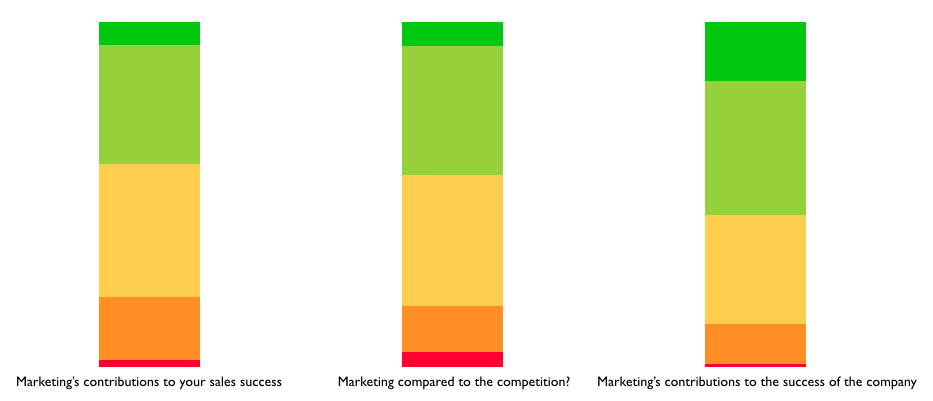
It’s a unique approach, and perhaps one that should be considered by others, because the challenge in performance management is often in defining the right metrics to drive the intended behaviors.
Ciena’s approach, as Dodd concludes, is to put the focus on the right conversation; “As we learned through the research, contributing to the success of the sales force isn’t just about one thing, it isn’t just lead gen. I appreciate that they give us credit for doing a good job when compared to competitors, but what we’re most interested in understanding is how well are we doing in enabling them to win. If the sales team rates our contributions as being valuable to their personal success, then we know we’re doing the right things.”
by scott.gillum | Apr 11, 2014 | 2014, Marketing
Take out a piece of paper, and write down what you think makes your company different from its competitors. Now, Google your competitors and see if you can tell the difference between what you wrote, and how they describe themselves. If it sounds the same, keep reading.
Let’s say you’re the CEO of a fortune 500 company looking for some advice. Two top tier global consulting firms are recommended, and based on their website descriptions of “Who They Are” which one would you chose?
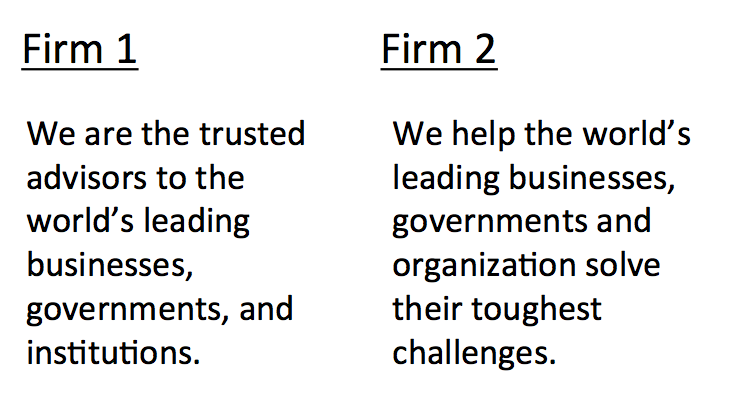
Can’t decide? That’s the challenge I’m talking about. Although one firm uses “advisors”, they are describing what the firms do, not who they are, and as you can see, the sound the same. If some of the smartest guys in the business are getting it wrong, and they’re the “advisors to the world’s leading businesses” you shouldn’t feel bad.
Why is it so hard? There are two key reasons; the first being in B2B, we are conditioned to think that what we do is who we are. It’s the Achilles heel of effective marketing communications, the bad habit of over communicating and focusing what you sell (what you do) versus who you are (what makes you different).
Making things worse is when B2B marketers talk about the value of what their company does, they use terms associated with business value, the functional benefit or business outcome of the product or service being sold (e.g. increase revenue, reduce cost, retain customers, etc.). It’s non-differentiating because competitors use the same language, and that’s the second major challenge to overcome.
Over the years, marketing communication has evolved from talking about how great the company was to talking about what it does for customers. Thankfully the “we’re number 1” days are over but unfortunately, the “what we do for customers” has been defined by what the company sells. It is time to evolve again and speak to more about the “DNA” of the organization. Research from CEB has shown that buyers figure out what companies sell (what you do) relatively quickly. It takes them much longer to figure out why they should buy from one company or another.
And surprisingly, when they do make the decision, it often has little to do with “business value” of the product or service itself, and more to do with the emotional connection they feel to it, or to your brand. Buyers are not the rational beings we once thought, they do business with businesses for very personal reason, according to the CEB research. As a result, they want to get to know the company as well as they know the product or service.
So, how do you “humanize” the company? Here are some tips to get your started:
- Ask customers – sounds obvious, but rarely happens. Ask them why they do business with your organization and others. You might be surprised by what you’ll learn; it may have nothing to do with your products or services. Use this information to communicate back to them “who you are” in the language and context that is meaningful to them.
- Survey employees – this may help uncover why the organization can’t get on the same page when it comes to defining the company. Employees have a tendency to define the company and what it does, based on their own experience with the products they know, and customers they serve. As a result, they have a myopic view of the organization. You will find multiple views on your value, and the type of company you are, across your organization.
- Decide on the type of company you are – pick up a copy of Michael Treacy’s Discipline of Market Leaders. In it, Treacy and Fred Wiersema define three value proposition types based on business models; Operational Excellence, Product Leadership, and Customer Intimacy. Use this framework as a starting point to define your organization and its’ language. It also helps get everyone on the same page.

- Create a persona – once you have consensus on the type of organization and its value to customers, it is time to figure how to differentiate it. In this step, use brand archetypes to help define the company persona. Here’s a free list of 40 archetypes. Create a working session and have the group discuss how the company views the world, how it reacts to bad or good news, how it speaks — what is the tone? Keep the conversation away from what the company makes or does, and on the organization itself.
Buyers have changed. They want to know who you are, because they already know what you do. And they’re looking for a little of themselves in your brand. Relate to them on a human level. Tell them who you are in a way that connects with them. If you do, it will differentiated you, because like people, no two organizations are exactly alike.
by scott.gillum | Mar 6, 2014 | 2014, Tech Trends
I had a dream last night that I was hiking along a stream with my family. The same path we’ve hiked and geocached dozens of times. Except this time, Siri’s voice interrupted our hike and asked if we’d like to play a game.
An app I had downloaded came on, and using GPS, our hiking history, and topographical maps of the area, had created a real time obstacle course, complete with the map, times to achieve, and “land mine” rocks to avoid. The “App” had proactively invaded our routine hike by creating a totally new experience.
When I awoke I wondered if I had read this, or if it was truly a dream. Concluding that it was a dream, I knew the article that helped to “inspire” it, and perhaps, playing a little too much Candy Crush may have lead to the creation of the “land mines”.
Earlier in the week, I had read about fitness apps that, for the first time, were positively impacting behaviors. I thought it was noteworthy because even with time spent on mobile devices continuing to grow, we have not invited them into our lives as an active participant, although my teenager may disagree with me. In 2013, Gartner reported consumers spent an average of 2 hours and 28 minutes per day on devices (phone and tablet), and 80% of that time spent inside apps.
Apps have been in “ondemand” mode waiting for us to engage. They haven’t been invited “in” because, for the most part, they haven’t been smart enough to provide us with value. With the era of the “internet of everything” we are entering a new world of connectedness. With devices able to communicate with each other, and soon apps, is this the beginning of new phase of app development?
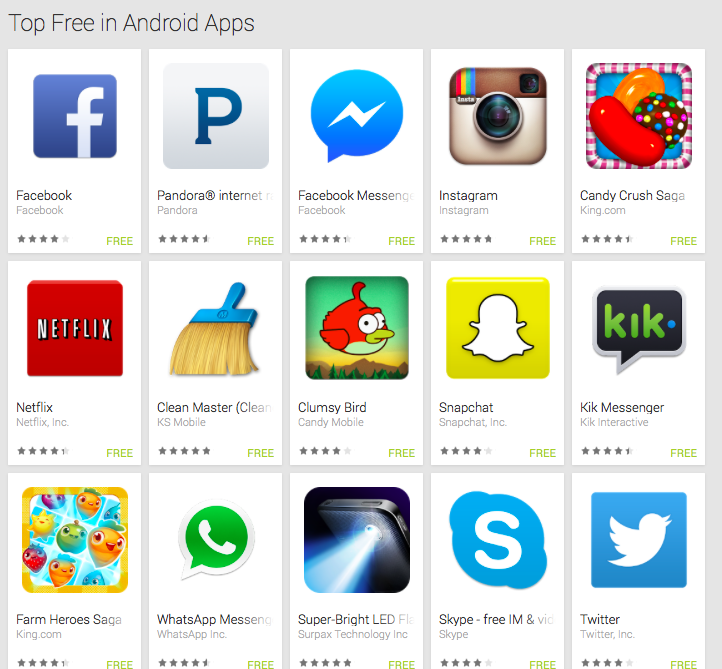
An era that goes beyond the first generation of “dumb” apps, similar to “dumb terminals” of yesteryear, in that they, with a few exceptions, mostly games, are nothing more than version of existing websites that have been optimized for mobile devices.
Next generation “smart” apps will have the potential to become an active part of our lives by tracking, and understanding our unique behaviors and habits, to creative highly personalized recommendations and experiences. But by 2017, Gartner predicts that mobile apps will have been downloaded more than 268 billion times, and mobile users will provide personalized data streams to more than 100 apps and service every day
Our mobile devices, which many of us carry 24/7, can remember where we’ve been, what we’ve done, and when we did it. They can listen in on our conversations, as we’ve learned, and can access data we have stored on the device and in the cloud.
As a result, be on the watch for the following in the near future:
- The emergence of “small data” – the value and functionality of your mobile device will shift from connectivity to data capture and transfer. In a sense, your phone will act as your own “black box” recording your daily activity, similar to a flight recorder. Apple and Google have the ability to track activity across devices so that most of your waken hours will be captured.
- A “listening” mode on your phone – it already exists the difference is that it will be a setting you control (instead of others). This will add a layer of richness to the data that is already being collected and enable apps to pick their spots to intervene with information, recommendation, etc.
- Highly personalized experiences – apps will leverage multiple sources of data and with artificial intelligence begin to create experiences and recommendations in real time, much of it designed around our daily lives and routines.
- Intelligent Ads – yes, someone has to pay for the free apps and advertisers will be at the ready. As the apps get smarter, so will marketers! Ads will appear at the right time, with relevant offers based on your interest, past buying behavior, and preferences. Some will be rewards based on certain behaviors, and other offers will incent them.

Signs of these types of apps are starting to appear. Apps like the Sleep Cycle alarm clock, that gently wakes you by analyzing your sleep patterns. Using your iPhone as an accelerometer, Sleep Cycle monitors your movement to determine which sleep phase you are in (see the image on the right). Once learned, the phone alarm then wakes you with soothing sounds in your lightest sleep phase.
Think of the convenience of having an app on your phone listen in on conversations when you’re traveling abroad and translate, in real time, in the dialect of that region. Or, as in my dream, the value of taking a routine outing and creating a totally new and highly engaging experience.
Of course progress comes with a cost. Increasing the availability of personal data also increases the threat of those who would like to get their hands on it. In fact, it will slow the progress of this smart app generation. That said, we will see improved security built into devices, and hopefully, there will be “an app for that” as well.
by scott.gillum | Jan 28, 2014 | 2014, Marketing
In December, I had the opportunity to be the Keynote speaker at the Bowery Capital CMO Summit in NYC. The event featured a number of high profile CMO’s speaking with an audience of mostly early stage startups (under 20 employees).
My presentation was based on the recent Forbes blog post Everything We Thought We Knew about B-to-B Marketing in Wrong. The audience also included some local media, a reporter from CMO.com wrote a summary of the speech.
http://vimeo.com/82457497
by scott.gillum | Jan 13, 2014 | 2014, Opinion
At this time of year the test scores of high school students from around the world are released. US student performance on the PISA Math, Reading and Science tests are compared to their peers from 55 countries. And every year we hear how our kids scored at the “average” level, seemingly falling further behind a half dozen or more countries.
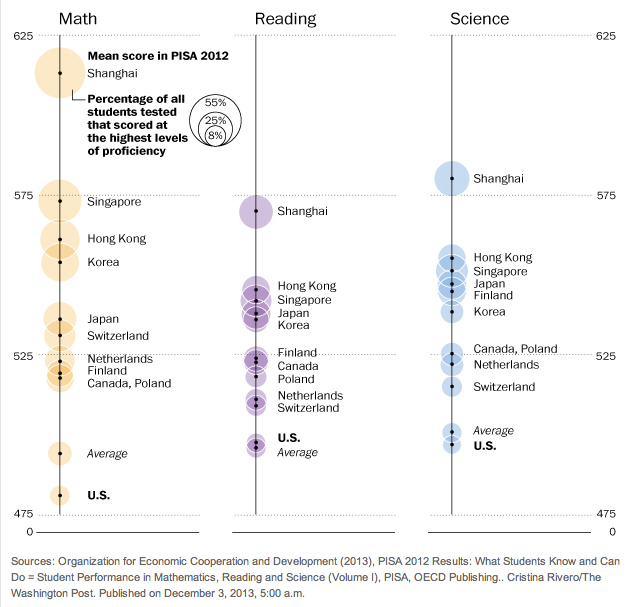 But are these results really indicative of our future success, are we really doomed to losing our “competitive edge” as some critics would argue?
But are these results really indicative of our future success, are we really doomed to losing our “competitive edge” as some critics would argue?
Maybe not, according to Peter Sims, in his book Little Bets. Sims argues that educational systems are built upon teaching facts then testing us in order to measure how much we have retained. Students who are taught to solve math problems, for example, focus on learning established methods of logical inference or deduction, both highly procedural. Improving test performance is a matter of becoming more proficient at retaining and applying established practices.
The risk, according to Sims, is that students are graded primarily on getting the answers right, and not encouraged to creatively problem solve using their own methods. The consequence is that our right-brain capacities to create and discover get suffocated.
This overemphasis on left-brain analytical skill development is a concern for many educator reformers. As author, Sir Ken Robinson, describes it in his Ted Talks video Do Schools Kill Creativity? “We are educating people out of their creativity.”
Robinson argues that the modern education system was crafted after the industrial revolution to support operational management practices that emphasize efficiencies and productivity objectives. But the emphasis on sequential processes, regimented systems and detailed planning results in the stifling of innovative capacities.
In doing research for his new book World Class Learners: Educating Creative and Entrepreneurial Students Yong Zhao compared the results of the PISA Math scores and the GEM (Global Entrepreneurship Monitor) annual assessment. GEM assesses the entrepreneurial activities, aspirations and attitudes of individuals in over 50 countries, 23 of which participate in the PISA test.
 Zhao found an interesting and surprising result. There was an inverse correlation between test scores and perceived entrepreneurship capabilities. Top PISA performing countries like Korea, Singapore, Taiwan and Japan, scored the lowest on perceived capabilities or confidence in their ability to start a new business.
Zhao found an interesting and surprising result. There was an inverse correlation between test scores and perceived entrepreneurship capabilities. Top PISA performing countries like Korea, Singapore, Taiwan and Japan, scored the lowest on perceived capabilities or confidence in their ability to start a new business.
This also highlights another important, and often overlooked result from the PISA findings about the importance of the mind-set of the students taking the test. As the article in the Washington Post noted;” Despite their tepid math scores, U.S. teenagers were more confident about their math skills than their international counterparts…”
Research from Dr. Carol Dweck, a professor of social psychology at Stanford University, a leading expert on why people are willing (and able) to learn from setbacks, found that people tend to lean toward one of two general ways of thinking about learning and failure; fixed mind-set and growth mind-set.
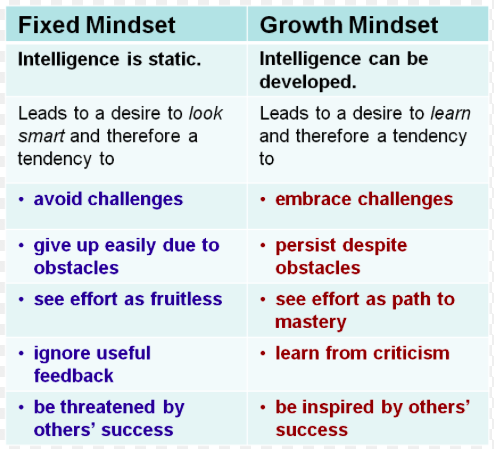 Fixed mind-set students believe in their abilities and innate set of talents, which creates an urgency to repeatedly prove those abilities, and perceive failure as threatening to their sense of self worth or identity. They are likely to be overly concerned seeking validation, such as grades, test scores and titles.
Fixed mind-set students believe in their abilities and innate set of talents, which creates an urgency to repeatedly prove those abilities, and perceive failure as threatening to their sense of self worth or identity. They are likely to be overly concerned seeking validation, such as grades, test scores and titles.
Students identified to be growth-minded believe that intelligence and abilities can be developed through effort, and tend to view failure as an opportunity for growth. They have a desire to be constantly challenged.
In her research with elementary school students, Dweck found that mind-set is strongly influenced by what a student thinks is more important: ability or effort. She found that students praised for their effort, “You worked really hard” versus ability “You must be smart”, where more likely to chose the more difficult task and creatively problem solve. Most importantly, when they failed they did not think their performance reflected their intelligence.
This insight would help to explain why students who are seen as “failures,” in the tradition sense, like Steve Jobs, are able to succeed and thrive in the face of diversity. It also helps to explain why in the US, students like Bill Gates or Mark Zuckerberg, who drop out of college, which would be shameful or unheard of in other countries, are able to go on to build billion dollar companies and change the world.
As the parent of two high school children, I’m not saying that testing student abilities doesn’t have its merits, but I am suggesting it isn’t the only measure of predicting a student’s, or country’s, future success.
The US has had a long tradition (and a culture) of producing rule breakers, game changers and out of the box thinkers. All of which is not easily measured by test scores, but better captured in the form of optimism, perseverance, and innovation. Perhaps being “average” is the right result to ensure that we are not, as Robinson would say, “educating people out of their creativity.”















